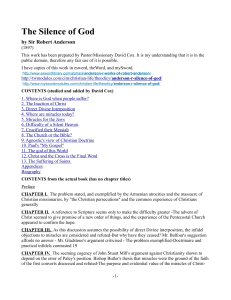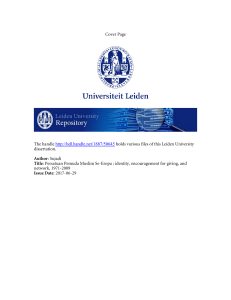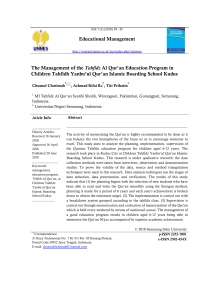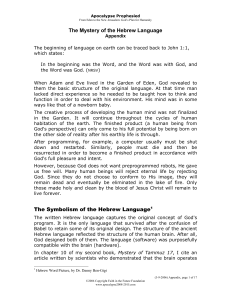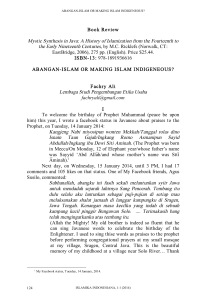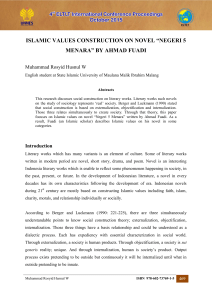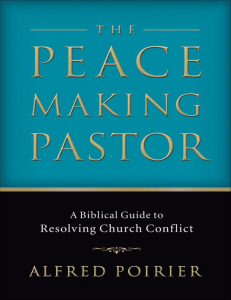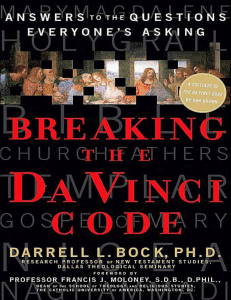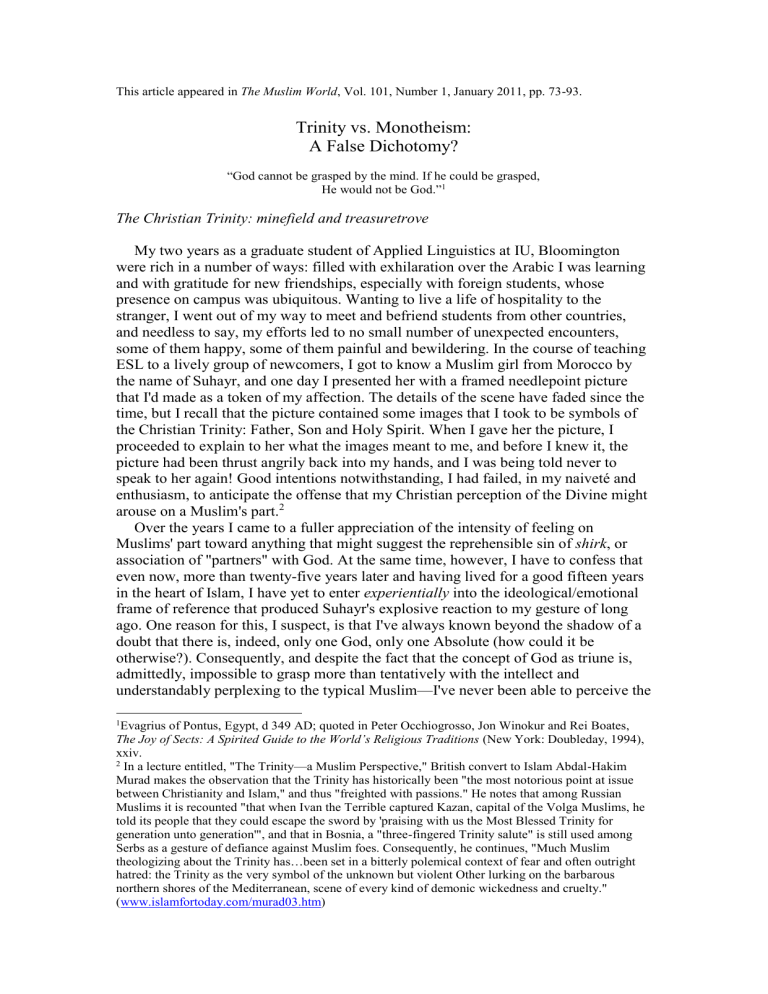
This article appeared in The Muslim World, Vol. 101, Number 1, January 2011, pp. 73-93.
Trinity vs. Monotheism:
A False Dichotomy?
“God cannot be grasped by the mind. If he could be grasped,
He would not be God.”1
The Christian Trinity: minefield and treasuretrove
My two years as a graduate student of Applied Linguistics at IU, Bloomington
were rich in a number of ways: filled with exhilaration over the Arabic I was learning
and with gratitude for new friendships, especially with foreign students, whose
presence on campus was ubiquitous. Wanting to live a life of hospitality to the
stranger, I went out of my way to meet and befriend students from other countries,
and needless to say, my efforts led to no small number of unexpected encounters,
some of them happy, some of them painful and bewildering. In the course of teaching
ESL to a lively group of newcomers, I got to know a Muslim girl from Morocco by
the name of Suhayr, and one day I presented her with a framed needlepoint picture
that I'd made as a token of my affection. The details of the scene have faded since the
time, but I recall that the picture contained some images that I took to be symbols of
the Christian Trinity: Father, Son and Holy Spirit. When I gave her the picture, I
proceeded to explain to her what the images meant to me, and before I knew it, the
picture had been thrust angrily back into my hands, and I was being told never to
speak to her again! Good intentions notwithstanding, I had failed, in my naiveté and
enthusiasm, to anticipate the offense that my Christian perception of the Divine might
arouse on a Muslim's part.2
Over the years I came to a fuller appreciation of the intensity of feeling on
Muslims' part toward anything that might suggest the reprehensible sin of shirk, or
association of "partners" with God. At the same time, however, I have to confess that
even now, more than twenty-five years later and having lived for a good fifteen years
in the heart of Islam, I have yet to enter experientially into the ideological/emotional
frame of reference that produced Suhayr's explosive reaction to my gesture of long
ago. One reason for this, I suspect, is that I've always known beyond the shadow of a
doubt that there is, indeed, only one God, only one Absolute (how could it be
otherwise?). Consequently, and despite the fact that the concept of God as triune is,
admittedly, impossible to grasp more than tentatively with the intellect and
understandably perplexing to the typical Muslim—I've never been able to perceive the
1
Evagrius of Pontus, Egypt, d 349 AD; quoted in Peter Occhiogrosso, Jon Winokur and Rei Boates,
The Joy of Sects: A Spirited Guide to the World’s Religious Traditions (New York: Doubleday, 1994),
xxiv.
2
In a lecture entitled, "The Trinity—a Muslim Perspective," British convert to Islam Abdal-Hakim
Murad makes the observation that the Trinity has historically been "the most notorious point at issue
between Christianity and Islam," and thus "freighted with passions." He notes that among Russian
Muslims it is recounted "that when Ivan the Terrible captured Kazan, capital of the Volga Muslims, he
told its people that they could escape the sword by 'praising with us the Most Blessed Trinity for
generation unto generation'", and that in Bosnia, a "three-fingered Trinity salute" is still used among
Serbs as a gesture of defiance against Muslim foes. Consequently, he continues, "Much Muslim
theologizing about the Trinity has…been set in a bitterly polemical context of fear and often outright
hatred: the Trinity as the very symbol of the unknown but violent Other lurking on the barbarous
northern shores of the Mediterranean, scene of every kind of demonic wickedness and cruelty."
(www.islamfortoday.com/murad03.htm)
Trinitarian vision of God as offensive or blasphemous. On the contrary, thinking of
the Divine as being "relational" within Himself/Herself/Itself remains, to this day, a
source of solace to me. In his study, Myth and Ritual in Christianity, Alan Watts
observes that the Biblical affirmation that "God is love" (I John 4:8) may be said to
imply the Trinity. He writes,
Deus est caritas. God is love—but love implies relationship, and this relationship is constituted
by the Father as the Lover, the Son as the Beloved, and the Holy Spirit as the very Love.3
In what follows I would like to approach this statement by Watts from a
number of different angles, some experiential and some analytical. Through these
varied approaches, I hope to show, on one hand, that when the Trinity is thought of in
the metaphorical terms appropriate to such a mystery, it need not be shunned as a
violation of the monotheism so central to Islam and Judaism, and so fiercely guarded
by the faithful Muslim or Jew. At the same time, I want to caution Christians against
rigid, doctrinaire adherence to trinitarian formulas that require one to conceive of God
as three "Persons" in One without considering the possibility that the ultimate Reality
in His (Her/Its) Oneness might not correspond perfectly to humanly comprehensible
categories.
In this connection I will be discussing Modalism (also known as Sabellianism)
as one possible way of conceptualizing the Trinity. However, although I draw
attention to the merits of Modalism, my purpose in this discussion is not to argue that
Western churches need to adopt Modalism in order to remain faithful to the
monotheistic principle and/or in order to convince Muslims that Christianity is
essentially monotheistic (although the modalistic view might, in fact, resonate more
fully with the Quranic revelation than a strictly Nicean or Chalcedonian formulation).
Rather, my purpose is simply to stress the view that the biblical data is so
inconclusive on the subject of a "trinity" that it is misguided and, at times, even tragic
to insist on one particular understanding of the Trinity as doctrine at the expense of all
others. This tragedy has been played out in the history of the Church in its persecution
of non-trinitarian Christian thinkers. Another tragic aspect of the insistence on one
sole "orthodox" understanding of the Trinity is that it has closed doors to muchneeded dialogue and understanding between Christians and adherents of other faiths,
most particularly Jews and Muslims, down the centuries.
The God whom Jews and Christians are commanded to love and obey is "one
Lord" (Deuteronomy 6:5). As Paul reminds his Christian readers, "There is no god but
One..." (I Corinthians 8:6). Similarly, the Muslim affirms several times in every
canonical prayer that "there is no god but God." With this as our common foundation,
may we tread gently and reverently into the realm of trinitarian thinking: open to
mining its treasures and, at the same time, cautious lest we overstep the bounds of
humility, thereby finding ourselves in a minefield of needless doctrinal controversy
that does nothing but distract us from the task at hand, namely, to love our one God
with all our hearts, souls and minds, and our neighbors as ourselves.4
Trinity in unity: the meaning of "persons"
The concept of God as triune is found nowhere explicitly in the New
Testament. Rather, the understanding of God as being three-in-One developed in an
3
4
Alan W. Watts, Myth and Ritual in Christianity (Boston: Beacon Press, 1968), p. 31.
Matthew 22:36-40.
attempt to make sense of the understandings of the Divine that had come to light
through the life of Christ and its impact on the lives of his followers. That is to say, it
is an inference based on the ways in which Jesus Christ spoke and acted and the ways
in which his ongoing presence was experienced by his followers after his death and
resurrection. The notion of God as being "three-in-One" is also based on the ways in
which Jesus spoke of the Holy Spirit, who was experienced and spoken of by the early
Christian community as an active participant, with Christ, in the Divine activity on
earth.5 As one trinitarian Christian thinker has pointed out, the Trinity should not be
approached as a speculative matter. Jesus, he reminds us, "did not speculate on how
God was a Trinity—he said, 'If I by the Spirit of God cast out devils, the kingdom of
God is come nigh unto you.' Here the Trinity—'I', 'Spirit of God', 'God'—was not
something to be speculated about, but was a working force for redemption."6
Throughout his prophetic ministry, Christ addressed God regularly as
"Father", and in both his words and his actions, he demonstrated the awareness of a
relationship with the God who had sent him which was so intimate that it came to be
perceived as one of actual identity:7 "All things have been delivered to me by my
Father," he declared, "and no one knows the Son except the Father, and no one knows
the Father except the Son, and anyone to whom the Son chooses to reveal Him"
(Matthew 11:27; cf. 5:1-33). Then, following Jesus' death and resurrection and his
followers' experience of receiving what Jesus had spoken of as "the promise of the
Father"—namely, the pouring out of the Holy Spirit upon them in such a way that
they were empowered to communicate to others about Christ in languages other than
their own and perform miracles of healing in his name8--Jesus' followers became
convinced that by virtue of his ongoing presence among them, he was being shown to
be united with God to a degree they had failed to perceive before. As Peter announced
to a gathering of fellow Jews, "Let all the house of Israel…know assuredly that God
has made him both Lord and Christ, this Jesus whom you crucified" (Acts 2:36). Paul
wrote that it was through Jesus' resurrection from the dead that he had been
"designated Son of God in power according to the Spirit of holiness...." (Romans 1:3).
Paul attributes creative power and pre-existence to Christ, who is said to be the locus
of "the whole fullness of deity" (Colossians 1:15-17; 2:9). These considerations,
together with the words attributed to Jesus at the conclusion to the Gospel of
Matthew—"All authority in heaven and on earth has been given to me. Go therefore
and make disciples of all nations, baptizing them in the name of the Father and of the
Son and of the Holy Spirit"9—led to attempts to make sense of such statements in
light of the strict monotheism that had served as the bedrock for Christian
discipleship. Hence, the formulation of the doctrine of the Trinity took place in part as
a response to the post-Easter experience of Christ as a divine reality, which presented
a dilemma in that it seemed incompatible with monotheism.10 Over time, relevant
New Testament references to God, Jesus Christ and the Spirit of God were gathered
5
See Luke 4:16-19; John 14:25-26, 16:12-15; Acts 1:1-5, 8; 2:1-4; 3:1-16; 4:8-10, 23-31; 7:55-60;
15:28; Romans 8:9-11, 14-16.
6
E. Stanley Jones, Christ of the Indian Road (New York: The Abingdon Press, 1935), p. 182.
7
See John 1:1; 8:58; 10:10, 38; 20:28.
8
See Acts 1:1-5 and 2:1-3:9.
9
Matthew 28:18-19. Doubts have been cast by some on the authenticity of Matthew 28:19 in its
present form, one reason for which is that in Luke's Acts of the Apostles, believers are only said to have
been baptized "in the name of Jesus Christ" (Acts 2:38, 10:48) or "in the name of the Lord Jesus" (Acts
8:16, 19:5).
10
See Marcus J. Borg, The God We Never Knew: Beyond Dogmatic Religion to a More Authentic
Contemporary Faith (New York: HarperCollins Publishers, 1997), pp. 97-98.
together as the basis for a more systematic conceptualization of God as a Trinity—one
God in three "persons" and one "substance"—as a means of defending the Church
against charges of worshiping two or three gods, and of combating what were
believed to be heretical teachings concerning how God, Jesus Christ and the Holy
Spirit are related.11
It was at the First Council of Nicea in 325 AD that the Trinity was established as
orthodox Christian belief. The Nicene Creed reads:
I believe in one God, the Father Almighty, Maker of heaven and earth, and of all things visible
and invisible.
And in one Lord Jesus Christ, the only-begotten Son of God, begotten of the Father before all
worlds; God of God, Light of Light, very God of very God; begotten, not made, being of one
substance [homoousias] with the Father….
And I believe in the Holy Ghost, the Lord and Giver of life; who proceeds from the Father and
the Son; who with the Father and the Son together is worshipped and glorified; who spoke by
the prophets….
However, as Raimundo Panikkar points out in his essay, The Trinity and the Religious
Experience of Man, it should be borne in mind that words such as "Trinity", "person"
and "substance" are used nowhere in the New Testament, and that "the first
generations of Christians lived out their faith in the Trinity without even knowing
them."12 And as Karen Armstrong observes concerning the Apostle Paul, "He had
never heard of the Holy Trinity in our sense, even though he speaks of the Father, the
Son and the Spirit.”13
"Strictly speaking," states Panikkar, "it is not true that God is three
Persons…," that is, if we restrict our understanding of the term "Person" to what we
know from human experience, where a person is generally perceived as a separate,
individual entity. However, he continues,
For want of a better term, one could certainly call them "persons" in so far as they are real
relative oppositions at the heart of the divine mystery, but one must beware of substantializing
them or considering them "in themselves." A person is never in himself, but by the very fact that
he is a person is always a constitutive relation… 14
Similarly, Borg notes that the three "persons" spoken of in the Trinitarian
formulation refer not to persons as we normally conceive of them; rather, the Latin
word persona used in the ancient texts was the term used for the masks worn by
actors in Greek and Roman theaters. Such masks, he tells us, "were worn not for
concealment, but corresponded to roles." Hence, the concept of the Trinity envisages
God in three distinct roles. One of these roles is that of earthly manifestation, and it is
this role which is played by Christ as the human manifestation of the eternal Son, who
in turn is associated with the divine Word, or Logos.15 For Jesus' followers, he had
become the means by which they recognized God. Hence, Paul spoke of seeing "the
11
The Oxford Companion to the Bible, edited by Bruce Metzger and Michael Coogan (1993), pp. 782783.
12
Raimundo Panikkar, The Trinity and the Religious Experience of Man: Icon—Person—Mystery (New
York: Orbis Books, 1973), p. 41.
13
Karen Armstrong, The First Christian: Saint Paul’s Impact on Christianity (London and Sydney:
Pan Books, 1983), p. 128.
14
Panikkar, Trinity, p. 52.
15
See Borg, The God We Never Knew, pp. 97-98.
light of the knowledge of the glory of God…in the face of Jesus Christ" (II Cor. 4:6).
Commenting on this verse, Bishop Kenneth Cragg writes, "What a face is to a human
person, the place of recognition, Jesus is to God."16
A modern Christian thinker who, in dialogue with a Muslim, stressed the
importance of caution when describing the Trinity in terms of "person" was Trappist
contemplative Thomas Mertion (d. 1968).17 In the course of a years-long
correspondence between Merton and a Pakistani Muslim by the name of Abdul Aziz,
the two men probed more and more deeply for understanding of each other's faiths
and their most central doctrines. At one point, in August 1963, Abdul Aziz asked
Merton to explain to him, among other things, the doctrine of the Trinity. In Merton's
response to Abul Aziz’s questions, he began by stressing the common ChristianMuslim belief in God’s oneness, saying,
Just as you (and I too) speak with reverence of Allah Rahman and Rahim, 18 so I think you can
see that speaking of Father, Son and Holy Ghost does not imply three numerically separate
beings. The chief thing that is to be stressed before all else is the transcendent UNITY of God.
Now as this unity is beyond all number, it is a unity in which "one" and "three" are not
numerically different. Just as Allah remains "one" while being compassionate and merciful, and
His compassion and mercy represent Him in different relations to the world, so the Father and
Son and Holy Spirit are perfectly One, yet represent different relations.
But there is of course a distinction: Rahman and Rahim are "attributes" and "names" of God, but
not subsisting persons. Here the trouble comes in the definition of person. The idea of "person"
in God is by no means the same as the current and colloquial idea of "person" among men:
where the "person" is equivalent to the separate individual man in his separateness. This is of
course where the confusion comes, in speaking of the "Three Persons" in God. This naturally
conjures up an image of three separate beings, three separate individuals. The idea of Person
must not be equated with that of individual. And, once again, "three" is not to be taken
numerically.19
In another letter to Abdul Aziz, Merton notes that certain Christian mystics of the
fourteenth century, including Meister Eckhart, who was influenced by Avicenna (Ibn
Si>nā), came very close to Islam in their thinking. Merton explains that
the culmination of their mysticism is in the "Godhead beyond God" (a distinction which caused
trouble to many theologians in the Middle Ages and which is not accepted without qualification)
16
Kenneth Cragg, Jesus and the Muslim An Exploration (Oxford: Oneworld Publications, 1985, 1999),
p. 230.
17
In December, 1951, while working as an assistant customs collector in Karachi, Abdul Aziz had
asked his Catholic boss, one A. E. Wright, to recommend to him a good book on Christian mysticism.
In response, Wright suggested that he read Thomas Merton's Ascent to Truth, which had been
published that same year. After reading Merton's book, Abdul Aziz initiated a correspondence with
Louis Massignon (d. 1962), the famed French Orientalist who devoted much of his life to a study of
Muslim mystic al-H{alla>j. It was Massignon that gave Abdul Aziz Merton's address, and in 1960
there began a correspondence between Abdul Aziz and Merton that was to continue until the latter's
death, and which has been described as "one of the most interesting epistolary exchanges between a
Muslim and a Christian in the twentieth century" (Sidney Griffith, "'As One Spiritual Man to Another'"
The Merton-Abdul Aziz Correspondence," in Baker and Gray Henry, eds. Merton & Sufism: The
Untold Story: A Complete Compendium, Louisville: Fons Vitae, 1999, pp. 101-102).
18
The words Rahman (Rah{ma<n) and Rahim (Rah{i>m) are generally translated, "Most
Compassionate" and "Most Merciful."
19
Letter dated October 18, 1963, quoted in Sidney Griffith, "As One Spiritual Man to Another: The
Merton-Abdul Aziz Correspondence," in Rob Baker and Gray Henry, eds. Merton & Sufism: The
Untold Story, p. 111.
but at any rate it is an ascent to perfect and ultimate unity beyond the triad in unity of the
Persons. This is a subtle and difficult theology and I don’t venture into it without necessity. 20
Without venturing into the subtle and difficult theology of Meister Eckhart's
"Godhead beyond God", Merton was able to present trinitarian thinking about God in
such a way that, although it inevitably eludes the grasp of logical, discursive thought,
he could nevertheless reach across the Muslim-Christian divide and confess without
hesitation "the supreme transcendent Unity of God." For here, and here always, the
Muslim stands together with the Christian, even the Christian who perceives God as
being, somehow, a triad within His ultimate Unity. As Cragg asserts emphatically,
"To read the Christian search, because of Jesus, for authentic statement of how 'God is
One' as disloyal to that truth is altogether to misread."21
The "persons" of the Trinity as modes of being: the Sabellian view
Like Borg above, Geoffrey Parrinder has pointed out that the Latin word persona
used in the Nicene Creed means, literally, a mask. In keeping with this
conceptualization, third-century priest and theologian Sabellius taught that Father,
Son and Holy Spirit were simply three forms or manifestations of the one God.
Parrinder tells us that
Sabellian teaching was partly absorbed and partly rejected in the theology of the Nicene Creed
and later, from the fourth century onwards. The equality of the different "aspects" or "persons"
was retained, but any suggestion of temporary "modes" of deity was rejected. 22
Nevertheless, speaking in what might be termed a Sabellian manner, Cragg asserts
that the term "God the Son" may be understood to mean "God in the act of
revelation." Developing this notion through an analogy to human experience, Cragg
writes,
When we speak of Beethoven the musician, or Leonardo da Vinci the artist, we mean these men
in their full personality in a particular capacity, capacities which do not preclude their having
others, but yet involving them wholly.” 23
Commenting on Cragg's illustration of the Trinity, one modern Muslim thinker writes,
If such is the interpretation and conception of the doctrine of the Trinity, a Muslim finds hardly
anything about which to differ from his Christian friends. The change of persons into attributes
is nothing which is derogatory to the integral character of God. This new conception and
interpretation is perhaps the re-echo of the beliefs of early Christian sects now extinct. It was
Sabellius (d. 215 AD) who maintained that Trinity was not a union of three persons but one
20
From a letter to Abdul Aziz dated May 13, 1961, quoted in Merton & Sufism, p. 124.
Cragg, Jesus and the Muslim, p. 193. Affirmation of Cragg's plea comes from Muslim thinker Khalid
Duran, who addresses fellow Muslims with the words, "In principle we should have no difficulty in
accepting that with Christians the belief in the Trinity is not polytheism, but a particular form of trying
to understand the One God and of being near to Him. Besides, the way Al-Qur'an speaks of Christians
as 'People of the Book' makes it plain enough that our revelation accepts them as monotheists,
otherwise there would not be that clear distinction between the 'People of the Book' and the idolworshiper." In this connection he quotes Qur'an 3:109, which commends "the People of the Book"
(both Jews and Christians) who "enjoin what is right and forbid what is wrong, vying with one another
in good works; those are righteous. Of the good that they do, nothing will be rejected. God knows the
godfearing." See Leonard Swidler, Khalid Duran and Reuven Firestone, eds., Trialogue: Jews,
Christians and Muslims in Dialogue (New London, CT: Twenty-Third Publications, 2007), p. 164.
22
Geoffrey Parrinder, Jesus in the Qur’an (Oxford: Oneworld Publications, 1965, 1995), p. 138.
23
Cragg, The Call of the Minaret, 1956, pp. 290ff.; cited in Parrinder, Jesus in the Qur'an, p. 140.
21
Person, [a] single Divine Essence, which manifested itself under three successive aspects, as
Father, Son and Holy Spirit. 24
Of course, the aspects of the Divine conceived of by Sabellius were not actually
"successive", but simultaneous (if not altogether timeless), a fact which is evident
from Christ (the Son)'s addressing God as Father, and the work of the Holy Spirit that
was ongoing throughout Jesus' ministry and beyond.
According to Sabellianism, also known as Modalism, the three "persons" of the
Godhead are not permanent distinctions but, rather, function as "modes" of God's
being and activity, may be seen as a response to the semantic and theological
difficulties that can arise from the use of the term "persons" when speaking of God as
triune, since this term can easily give rise to the misconception of the Trinity as being
tritheistic. Although Sabellianism was rejected as a heresy, it nevertheless makes the
Trinitarian understanding of God far easier to grasp and accept, and in fact has great
intuitive appeal. One thinks, in this connection, of the revolutionary discoveries made
over the past century in the field of subatomic physics and the realization to which
such discoveries have led, namely, that the boundaries we believe to be so solid
between this and that entity are, in fact, illusory, and that there is no real distinction
between mass (read: "substance", "person") and energy (read: "mode", "activity").
Research in the field of quantum physics has shown that a subatomic particle is what
it does; its existence consists solely in its relations to other subatomic particles.
Hence, the insistence on the so-called "Persons" or hypostases within God (of which
the Bible never speaks to begin with) being distinct entities rather than functions of
their activities may not, in fact, correspond to the way things really are.
So appealing was Sabellianism that not only did it gain wide popularity
between the second and fourth centuries AD,25 but is said to have had a significant
influence on later Christian thinkers and reformers. One individual of particular note
in this connection is Michael Servetus (d. 1553), a Spanish physician and theologian
known to have been the first European to describe the function of pulmonary
circulation.26 In 1531, following a period of extensive reading, Servetus published De
trinitatis erroribus ("On the Errors of the Trinity"), which was followed the next year
by Dialogorum de Trinitate ("Dialogues on the Trinity") and De Justitia Regni Christi
("On the Justice of Christ's Reign"). In these works Servetus argued that the doctrine
of the Trinity as embodied in official church creeds is without Biblical foundation. It
was Servetus' belief that the divine Logos had become manifest in Jesus Christ when
God's spirit entered the Virgin Mary's womb. Consequently, it was not the man Jesus
Christ who was eternal but, rather, the Logos that had been manifested in him. It was
for this reason that Servetus refrained from calling Jesus "the eternal Son of God",
calling him instead, "the Son of the eternal God."27 In a similar vein, Alan Watts
cautions against the confusion that results from "application of the term 'only-begotten
24
S. M. Tufayl, in Forum, June 1960; cited in Parrinder, Jesus in the Qur'an, p. 140.
In ca. 375 AD, Epiphanius (Haeres 62) noted that adherents of Sabellius' teaching were still to be
found in great numbers in Mesopotamia and Rome. The Second Ecumenical Council of Constantinople
held in 533 AD declared the baptism of Sabellius to be invalid, thereby indicating that Sabellian
teaching continued to enjoy popularity at that time (see
www.newworldencyclopedia.org/entry/Sabellianism).
26
In the thirteenth century AD, this same discovery had been made separately by 'Ala> al-Di>n Abu>
al-H{asan 'Ali> Ibn Abi> al-H{azm al-Qarashi al-Dimashqi> (known as Ibn al-Nafi>s) (d. 687 AH,
1288 AD) in Damascus. However, due to cultural and linguistic restrictions, Ibn al-Nafi>s' work was
not transmitted to Europe until a later time.
27
De trinitatis erroribus, Book 7.
25
Son' to Jesus as man, whereas it refers strictly to the Eternal Word 'begotten before all
ages.'"28
Servetus' motive for writing such works was, in fact, an ardent love for God
and the desire to spread what he believed to be a truly Biblical Christianity.
Significantly, Servetus expressed the hope that elimination of Trinitarian dogma
would give Christianity greater appeal to Jews and Muslims, for whom the unity of
God is such a central tenet of faith.29 Describing Servetus' writings, one scholar
asserts,
Servetus' Errors of the Trinity is hardly heretical in intent; rather, [it] is suffused with passionate
earnestness, warm piety, an ardent reverence for Scripture, and a love for Christ so mystical and
overpowering that [he] can hardly find words to express it….Servetus asserted that the Father,
Son and Holy Spirit were dispositions of God, and not separate and distinct beings. 30
Interestingly, Servetus denied that his views reflected Sabellianism, which, in his
view, confuse the "Father" with the "Son."31 Nevertheless, he was accused of heresy
by the French inquisition on the basis of a number of letters he had written to John
Calvin, and was sentenced to be burned along with his books. Having been denounced
by both John Calvin and Martin Luther, Servetus was condemned on the dual count of
promoting nontrinitarian beliefs and opposing infant baptism,32 and on October 27,
1553, he was burned at the stake just outside Geneva, Switzerland with one of his
books lashed to his arm. The last words he is said to have uttered were, "Jesus, Son of
the Eternal God, have pity on me!"33
As has been noted, the biblical evidence for the doctrine of the Trinity is
ambiguous, whereas a clear and firm Biblical foundation can be cited for divine unity.
God is explicitly declared to be "one" (cf. Deut. 6:4, "Hear, O Israel: The Lord our
God is one Lord…"; Isaiah 44:6, "…I am the first and I am the last, besides me there
is no God"; and I Cor. 8:4-6, "…there is no God but one"). Nowhere, however, is He
declared to be three. This, together with the abstruse, confusing nature of the
28
Watts, Myth and Ritual, p. 130.
In a work entitled A Letter Written in the Year 1730 Concerning the Question Whether the Logos
Supplied the Place of a Human Soul in the Person of Jesus Christ (1st Edition, London, 1759),
Nathaniel Lardner argued that "primitive Christianity" had first been corrupted by certain "Christian
Pythagoreans and Platonists" by means of the doctrine of the Trinity in order "to make Christianity
more 'palatable' to pagan converts." (Jonathan Z. Smith, Drudgery Divine: On the Comparison of Early
Christianities and the Religions of Late Antiquity [Chicago: The University of Chicago Press, 1994], p.
9). Similarly, Servetus attributed the origins of the doctrine of the Trinity to the influences of Greek
philosophy rather than the gospel. He noted ruefully that this doctrine "incurs the ridicule of the
Mohammadans and the Jews" (Smith, Drudgery, p. 15, quoting E. M. Wilbur, A History of
Unitarianism [Boston, 1945], p. 3). The Trinity, claimed Servetus, is "a horrible invention" which
"causes 'Mohammadans to laugh' and Jews to dismiss Christianity as 'fancy', 'foolishness' and
'blasphemies'" (ibid., citing The Two Treatises of Servetus on the Trinity, translated by E. M. Wilbur
[Cambridge, MA: 1932], pp. 66-67). Similarly, John Biddle (d. 1663) assailed the Trinity as an
"absurdity" which has "corrupted almost our whole Religion" (Smith, Drudgery, p. 16; citing Biddle, A
Confession of Faith Touching the Holy Trinity, According to the Scripture, London, 1648, 1,
unpaginated).
30
Lawrence and Nancy Goldstone, Out of the Flames: The Remarkable Story of a Fearless Scholar, A
Fatal Heresy, and One of the 'Rarest' Books in the World (NY, NY: Broadway Books, 2002), pp. 7172.
31
Michael Servetus, Restitución del Cristianismo, Spanish edition by Ángel Alcalá and Luis Betés
(Madrid, Fundación Universitaria Española, 1980), p. 119.
32
Roland. H. Bainton, Hunted Heretic: The Life and Death of Michael Servetus 1511-1553, edited by
Peter Hughes, with an introduction by Ángel Alcalá (Blackstone Editions, 2005), pp. 164 and 141.
33
See Goldstone, Out of the Flames, p. 197.
29
discussions that have surrounded the Trinity over the ages, the plethora of heresies
which have arisen precisely in an attempt to make sense of the notion of God as three
in one,34 and the tragic end met by individuals who, like Michael Servetus, were
earnest seekers of truth, would surely indicate the need to avoid dogmatic
intransigence and literalism and, instead, to adopt a spirit of the utmost tolerance and
caution when it comes to beliefs concerning what it means to speak of God as triune.
Since Servetus' day, there has, quite fortunately, emerged a spirit of greater
tolerance among Christians in relation to such matters, and there now exist a number
of communities which, though they see themselves as fully Christian, do not
necessarily subscribe to trinitarian beliefs—among them Christadelphians, Oneness
Pentecostals and Christian Unitarians, who look upon Servetus as a spiritual
forebear—and who can argue convincingly for their beliefs from the Christian
scriptures. Hence, it is my hope that what we might term trinitarian Christians can
come to the realization that not all Christian believers are trinitarians, nor do they
need to be in order to be faithful to the message Jesus brought. Similarly, my hope is
that when trinitarian beliefs about God are understood metaphorically (or, to use
Schuon's term, esoterically), they can be affirmed even by Muslims as a valid
expression of belief in the one God.
Trinity in unity: a uniquely Christian distinctive?
A term that has been used in Christian theology in place of "Person" to speak
of the Father, the Son and the Holy Spirit is that of hypostasis, the literal meaning of
which is "that which stands under and supports." In an essay entitled, "The Interplay
of the Hypostases," Frithjof Schuon subjects what he terms elsewhere the "ternary
aspect" of the Divine35 to a philosophical analysis. In this analysis Schuon notes that
one aspect of the Absolute is infinitude, and that it is out of Its aspect as the Infinite
that the Absolute brings the world into existence. He writes:
This Absolute-Infinite is the Sovereign Good….Now the Good—according to the Augustinian
formula—tends essentially to communicate itself...which is say that the Absolute, being the
Sovereign Good, comprises thereby Infinitude and Radiation.36
The Absolute is Infinite; therefore It radiates, and in radiating, It projects Itself, the content of
this projection being the Good. The Absolute could neither radiate nor produce thereby the
image of the Good if It were not Itself, in its Immutability, both the Good and the
Radiation….This is the very foundation of what Christian doctrine terms the Hypostases. 37
Projection, moreover, necessarily entails a kind of polarization. Hence, Schuon
continues,
the Infinite…projects the Absolute and thus produces the image, and from the moment there is
image—this is the Logos—there is polarization, that is to say, refraction of the Light which in
Itself is undivided. The Good refracted, or the Logos, contains all possible perfections. 38
34
Such heresies include, for example, Adoptionism (which is likely to have reflected the original
"orthodoxy" of the Jewish Christian community), Docetism, Arianism, and Sabellianism.
35
Frithjof Schuon, The Transcendent Unity of Religions (Wheaton: The Theosophical Publishing
House, 1993), p. 26.
36
Schuon, From the Divine to the Human: Survey of Metaphysics and Epistemology, translated by
Gustavo Polis and Deborah Lambert (Bloomington: World Wisdom Books, 1981), p. 35.
37
Ibid., p. 37.
38
Ibid.
The Absolute, then, corresponds to the Father. Inherent in the Absolute is the
"principle of radiation or projection" which "corresponds to the 'Holy Spirit'", while
"the principle of polarization or refraction" corresponds to the Son.39
Schuon thus brings the discussion of the Trinity onto a highly abstract,
philosophical plane. In so doing, he helps to highlight the ternary aspect of the Divine,
or Absolute, as something which goes beyond the confines of Christian theology.
Schuon's analysis thus points to an insight into Reality which has been grasped within
other religious traditions as well, including both Hinduism and Islam. In an essay
entitled, "Mysticism", William Stoddart points out that the ternary Hindu appellation
for the Divine as Sat (Being)-Chit (Consciousness)-A>nanda (Bliss) may be
translated variously as Subject-Object-Union, Knower-Known-Knowledge or LoverBeloved-Love.40 Moreover, he goes so far as to say that "This Trinitarian aspect of the
Divinity is universal, and is found in all religions."41 This includes Islam as well, in
that "certain Sufi formulations evoke the selfsame Trinitarian aspect of the Divinity."
Specifically, we find that in the practice of dhikr, that is, invocation of the name of
God, God is said to be not only That Which is Invoked (al-madkhu>r), but, in
addition, the One Who Invokes (al-dha>kir), and the invocation (al-dhikr), which is a
variant way of conveying the "trinity" of Subject-Object-Union, or Lover-BelovedLove.42
One begins to wonder, then, whether there might be a universal, underlying
pattern to Reality that is ternary, i.e., trinitarian, in nature. Consider the intriguing fact
that in addition to the ternary Sat-Chit-Ananda by which Hindus have spoken of the
Absolute (Brahman), there is another formulation in which Brahman is personified
under three aspects: Brahma, the creator, Vishnu, the preserver, and Shiva, the
destroyer. Not only so, but the second member of this trinity, namely, Vishnu, is
believed by Hindus to incarnate himself periodically in human form. It seems highly
unlikely, given the vast distances geographically, linguistically and culturally that
separated ancient Hindu civilization from that of the first Christians, that there would
have been any direct influence at work here. Yet here we have, in two very disparate
contexts, a conception of the Divine as both One and Three which, unlike that of the
more philosophical triad of Sat-Chit-Ananda (Being-Consciousness-Bliss), involves
personification and distinguishable roles, one of which is a divine descent into the
human sphere, an incarnation, an avatar.
Hence, it is not without reason that in the introduction to his essay on the
Trinity, Panikkar asserts that
It is simply an unwarranted overstatement to affirm that the Trinitarian conception of the
Ultimate, and with it of the whole of reality, is an exclusive Christian insight or revelation. 43
39
Ibid.
In Lings, Martin and Clinton Minnaar, eds. The Underlying Religion: An Introduction to the
Perennial Philosophy (Bloomington, IN: World Wisdom, Inc., 2007), pp. 234-235. Stoddart gives the
translations as "Object-Subject-Union," "Known-Knower-Knowledge" and "Beloved-Lover-Love."
However, in keeping with the order given by Watts in his earlier reference to the Trinity as "the Father
as the Lover, the Son as the Beloved, and the Holy Spirit as the very Love" (Watts, Myth and Ritual, p.
31, emphasis added), I have altered the order of the first two elements. This, it seems to me, is more
reflective of the process of "radiation" described by Schuon above.
41
Ibid. p. 245.
42
Ibid., p. 235.
43
Panikkar, Trinity, p. viii.
40
Similarly, Schuon expresses the conviction that there is an underlying trinitarian
structure to all of reality. Thus, he concludes his essay, "On the Interplay of the
Hypostases" with the words:
Leaving aside all question of denominational overaccentuation, we will say that both
conceptions—the unitary and the trinitary—meet and are resolved in their archetype, which is
none other than the Absolute at once immutable and radiating; being what It is, the Absolute
cannot but be immutable, and It cannot but radiate. Immutability, or fidelity to Itself and
Radiation, or gift of Itself; there lies the essence of all that is. 44
Such considerations lead me to the thought that, if the Muslim comes to recognize
trinitarian thinking about God as an attempt to convey in conceptual terms a Reality
which, ultimately, is beyond conceptualization and which is, in fact, found within
religions other than Christianity, including both Hinduism and even Islam itself, it
may become easier for him or her to look upon the Trinity, not as a violation of the
Divine Unity but, rather, as a means of speaking about the Divine richness and
vitality.
In trinitarian thinking the divine richness is understood, first and foremost, in terms
of relationality, beginning with the communion in unity of the three "persons" or
hypostases of the Divine Being.45 The terms "Father" and "Son" are, first and
foremost, relational terms. One cannot be a parent without there being an offspring,
nor can one be an offspring without there being a parent. Hence, in referring to God as
"Father," the Christian tradition conceives of God as being eternally in a kind of
relation to Himself; this relationship of fatherhood is, in the eternal sense, with the
"Son". After reminding his readers that he is speaking in purely metaphorical terms,
Panikkar suggests that
The Spirit is the communion between the Father and the Son….Just as the Father holds nothing
back in his communication of himself to the Son…,
(In other words—to use Schuon's terminology again—just as the Absolute-Infinite
radiates or projects Itself, thereby producing the image of the Good which is Itself, the
refraction of the Undivided Light…)
so the Son does not keep to himself anything that the Father has given him. There is nothing that
he does not return to the Father.
(That is to say, the Light reflects back fully upon Itself.)
Thus the trinitarian cycle is completed and consummated, though in no way is it a "closed
cycle". The Trinity is, indeed, the real mystery of Unity, for true unity is trinitarian. 46
Thence we derive the Christian conception of God as love (I John 4:8) and the Trinity
as Lover/Father-Beloved/Son-Love/Holy Spirit, the Hindu conception of Being (sat)Consciousness (chit)-Bliss (ananda), and the Islamically familiar triad of Invoker
(dha>kir)-Invoked (madhku>r)-invocation (dhikr).
The phenomenon of trinity-in-unity can also be observed on the level of
human experience, that is, on the level of a person's experience of selfhood. I can say,
44
Schuon, From the Divine to the Human, p. 42.
Similarly, the ‘Most Beautiful Names’ of God referred to in the Qur’an (7:179/180; 17:110; 20:7/8;
and 59:24) may be construed in terms of relationality. After all, virtually every one of these names
contains a relational dimension.
46
Panikkar, Trinity, pp. 61-62.
45
"I love myself," "I hate myself," "I'm talking to myself," etc., all of which speaks of a
kind of "multiplicity" within the single conscious entity that is "I". The ternary aspect
is completed through the force or energy, be it positive or negative, that is generated
through this relationship that I have with myself: Self-hatred and self-denigration
produce an "aura" with real effects in the world, just as self-love and self-respect
produce an aura, albeit of the opposite sort. So, if such multiplicity-in-unity manifests
itself in the realm of human subjectivity, it stands to reason that God Almighty, in
whose image we were made, would be the ultimate Prototype of this phenomenon.
In an illustration of how fine, if not illusory, the distinction between trinitarian
and monotheistic conceptions of the Divine reality may actually be, the Persian Sufi
poet Ha>tif Is{faha>ni> describes in verse an encounter with a young Christian
woman in which he chides her for imposing "the shame of the Trinity" on the One,
and to which she replies sweetly,
"If thou art aware of the secret of the Divine Unity,
Do not cast on us the stigma of infidelity!" 47
In triple mirrors God, in endless love,
Has His resplendent countenance displayed.
Silk will not three things be, though it appears
Sometimes as satin, damask, or brocade.48
The intuitive nature of monotheism (or: The down side of Trinity as doctrine)
In a lecture given to a group of Christians in 1996, a British convert to Islam
remarked that
the Nicene talk of a deity with three persons, one of whom has two natures, but who are all
somehow reducible to authentic unity, quite apart from being rationally dubious, seems
intuitively wrong. God, the final ground of being, surely does not need to be so complicated!49
In so saying, this thinker echoes the sentiments of many, both past and present—some
of them Jews and Muslims, and some of them Christians who have been bewildered
by what Karen Armstrong terms "the peculiar complexity of the Christian creed."50 It
is this "peculiar complexity" that Armstrong suggests may help account for the
"strange yearning for ideological conformity" that has led to such awful persecutions
of those who—be they Arians, Nestorians, Monophysites, Albigensians, or whatever
other dissenting groups—have departed in their thinking and beliefs from official
church doctrine in relation to the nature of Christ's relationship to God. In discussing
the matter of why Islam has been so attractive to people of other faiths, including the
Christian faith, Armstrong observes that with the advent of Islam in the seventh
century AD,
47
Seyyed Hossein Nasr, Sufi Essays, Third Edition (Chicago: ABC International Group, Inc., 1999), p.
136; citing a translation by E. G. Browne in his A Literary History of Persia, vol. IV (Cambridge,
1930), pp. 293-294.
48
Cragg, Jesus and the Muslim, p. 62, citing a translation of the same poem by Norman Sharp. (No
further bibliographical information on the source of Sharp's translation is provided.) In this citation, I
have combined a portion of Browne's translation of the verse with Sharp's, which conveys the sense
more lyrically.
49
Abdal-Hakim Murad, "The Trinity—a Muslim Perspective," A lecture by an English convert to
Islam delivered in Oxford, 1996.
50
Karen Armstrong, Holy War: The Crusades and Their Impact on Today’s World (New York: Anchor
Books, 1988), p. 413.
So-called heresies that centered on the knotty problem of how Jesus could be both God and man
were rife throughout the Middle East and had, on occasion, been persecuted by the orthodox
Christians of Byzantium. The Muslim view of Jesus as a great and privileged Prophet made far
more sense, as did their policy of toleration to these long-suffering and puzzled Christians.
Again, in Spain, this Koranic view of Jesus greatly appealed to many of the Visigoths, who had
been converted to Arianism, 51 which had much the same view of Christ. 52
A number of heated and sometimes even violent controversies raged between
the second and seventh centuries AD over the proper way to formulate Christological
doctrine, all of which was bound up with the notion of God as triune not merely in a
philosophical, metaphysical sense, but as a doctrine that was to be adhered to in a
precise, quasi-literal manner as a prerequisite for one's eternal salvation. After
presenting an overview of this turbulent period of ecclesiastical history, Joseph
Campbell observes that against the background of six centuries of turbulence and
theological disputes, as well as persecution of those whose views did not conform to
the "orthodox" view of Christ's nature/s, the simple doctrine of la> ila>ha illa>
Alla>h ("There is no god but God") championed by Islam was bound to have
tremendous appeal.53 So powerfully did this doctrine resonate, in fact, that it "took
away the entire Middle East within two blazing decades and, flying the breadth of
North Africa, overran Spain in 711."54
The widely positive response with which Islam's message of simple
monotheism was met even—or perhaps one could say, particularly—in Christian
lands was most likely due to a number of factors. One of these factors, noted by both
Armstrong and Campbell, is the perplexing questions that arise when one seeks to
comprehend how the One Absolute could also somehow be Three, coupled with the
"strange yearning for ideological conformity" within Christendom that had led to both
a fear of heresy and a corresponding tendency to persecute those who failed to
conform to what had been declared orthodoxy where the nature of Christ and the
Trinity were concerned.
51
The term Arianism refers to the teaching of Arius (d. ca. 336), according to which Jesus Christ was
not of one substance (homoousia) with the Father, nor was he eternally pre-existing. According to
Arian teaching, God the Father ("unbegotten"), who has existed from all eternity, is to be distinguished
from the Son ("only begotten"), who was brought into existence before the beginning of time and
through whom the world was created. Working through the Son, the Father likewise created the Holy
Spirit, who is subservient to the Son as the Son is to the Father. Such teaching finds support in I
Corinthians 8:6, where Paul writes that "there is one God, the Father, from whom are all things and
from whom we exist, and one Lord, Jesus Christ, through whom are all things and through whom we
exist." Arius also based his teaching on passages such as John 14:28, in which Jesus states that "the
Father is greater than I," and John 17:20-21, where he prays that his disciples "may all be one, even as
Thou, Father, art in me, and I in thee, that they also may be in us…", thereby implying that the oneness
of Christ with the Father is a oneness of thought and will, not of essence. In 321 AD, Arius was
denounced by a synod at Alexandria for teaching a heterodox view of the relationship between Jesus
Christ and God the Father. By 325 AD, the controversy over Arius' teachings had become so acute that
the Emperor Constantine convened an assembly of bishops in the First Council of Nicea, which
condemned Arian teaching and formulated the original Nicene Creed, which describes Christ as being
homooousias, of one substance, with the Father. Following Constantine's death in 337, however, the
controversy was revived, and Constantine's son, Constantius II, supported the Arians and even set out
to reverse the Nicene Creed. Although trinitarianism ultimately prevailed, Arianism was dominant for a
number of centuries among certain Germanic tribes in western Europe, including the Goths, the
Lombards and the Vandals.
52
Armstrong, Holy War, pp. 44-45.
53
Campbell in The Masks of God: Occidental Mythology (New York: Penguin, 1964), p. 419.
54
Ibid.
Another, equally important factor underlying such positive responses to Islam
among Christian communities lies in the affinity to be found between these two faiths.
So close are Christianity and Islam to each other that, as Dalrymple notes, Christians
in their early encounters with Islam treated it as though it were a variant form of
Christianity. Even the theologian St. John of Damascus (d. ca. 787)—who grew up in
the Umayyad Court of Damascus and was a boyhood friend of the future caliph,
Yazid—regarded Islam as a form of Christianity. His book entitled, The Fount of
Knowledge contains a detailed critique of Islam in which he treats it as closely related
to the heterodox teachings of Arianism and Nestorianism.55 For like Nestorianism and
Arianism, Islamic teachings are consistent with the notion “that God could not
become fully human without somehow compromising his divinity.”56 Dalrymple
quotes the Nestorian patriarch as having written in the year 649 AD, “These Arabs
fight not against our Christian religion; nay, rather they defend our faith, they revere
our priests and saints, and they make gifts to our churches and monasteries.”57
Elsewhere Dalrymple reflects that "If a theologian of the stature of John Damascene
was able to regard Islam as a new—if heretical—form of Christianity, it helps to
explain how Islam was able to convert so much of the Middle Eastern population in
so short a time...."58 He notes that Islam's spread in Byzantium was enhanced by the
widespread resentment against the latter's ruthless insistence on the imposition of a
"rigid imperial orthodoxy" on the entire population. The response to this kind of
theological repression was a mass conversion to Monophysitism,59 followed by mass
55
A teaching that originated with Nestorius (d. 451), who served as Archbishop of Constantinople from
428-431 A\D, Nestorianism holds that Christ united within himself two separate natures, the divine
Logos and the human Jesus. Nestorius rejected the appellation theotokos (God-bearer) for Mary, calling
her instead, Christotokos (bearer, or mother, of Christ), since in Nestorius' view, Mary could only have
given birth to a human being, not to a pre-existent entity. Similarly, Nestorius held that Christ's divine
nature (the Logos) could not have suffered on the cross, but, rather, only his human nature. Nestorius
was accused of dividing Christ into two persons, and his views were condemned at the First Council of
Ephesus in 431 AD. As a result of this conflict, the Assyrian Church of the East separated from the
Byzantine Church, and due to a combination of religious and political factors, Nestorians migrated in
large numbers to Iraq and Iran. St. Cyril of Alexandria (d. 444 AD), a fierce opponent of Nestorianism,
issued twelve "anathemas" against Nestorius in 430 AD, and in 435 AD, Theodosius II issued an edict
condemning Nestorius' writings to be burned. Nestorius died in exile in the Egyptian desert.
Nestorianism has survived in the Assyrian Church of the East with jurisdiction in Iraq and Iran,
although this church denies that what it teaches is Nestorianism. There are some who hold that by
rejecting the term theotokos for Mary, modern Protestants teach a kind of "crypto-Nestorianism." As
one Orthodox writer states, "If Mary is not theotokos, then Christ is not God-man. Likewise, if Christ is
God-man, then Mary is theotokos." (see
http://orthodoxwiki.org/Nestorianism#Resistance_to_Nestorianism).
56
William Dalrymple, "Of Saints and Sufis in the Near East: Past and Present," in Roger Boase, ed.,
Islam and Global Dialogue: Religious Pluralism and the Pursuit of Peace ( London: Ashgate, 2005), p.
95.
57
Ibid.
58
William Dalrymple, From the Holy Mountain: A Journey Among the Christians of the Middle East
(New York: Henry Holt and Company, 1999), p. 299.
59
Monophysiticism (from the Greek monos, meaning "one" and physis, "nature") teaches that Christ
had only one nature (a human nature that evolved into a divine nature, or that was absorbed into deity).
Following the condemnation of Nestorianism at the First Council of Ephesus in 431 AD, an
archimandrite by the name of Eutyches (d. 456) emerged with the aforementioned view, which is
sometimes referred to as Eutychianism. Eutyches' views were rejected at the Fourth Ecumenical
Council at Chalcedon in 451 AD. According to the Chalcedonian formula, Christ's human and divine
natures were united "without confusion, conversion, separation or division." Therefore, everything that
Christ did or suffered was done or suffered by his whole person, including both his divine nature and
his human nature. The Council of Chalcedon thus reaffirmed the use of the term theotokos for the
Virgin Mary. The Chalcedonian Creed reads as follows:
conversion to Islam, which may well have seemed very close to the Monophysite
stance.60
***
The foregoing observations, in my view, suggest a number of things of
importance to Christians and Muslims. As I hope to have made clear, belief in the
Trinity as a three-way relationality within the Godhead is a valid expression of
monotheism which has manifested itself not only in Christianity, but in Hinduism and
(far more subtly) in Islam as well. At the same time, however, Christians who espouse
trinitarian beliefs should take care not to lose sight of the centrality of the Divine
Oneness, since it is this oneness that serves as the foundation for any trinitarian
thinking that purports to be faithful to the Biblical witness concerning God. As Cragg
asserts, "Whether we are Muslims or Christians, the ultimacy and supremacy are
always God's."61 And as Paul reminded those in the church at Corinth, "You are
Christ's, and Christ is God's" (I Corinthians 3:23).
The Qur'an and the Trinity: a providential misinterpretation?
Lastly, we come to an examination of Qur'anic texts that have been understood
traditionally as rejections of a trinitarian view of God. Interestingly, Geoffrey
Parrinder proposes that what the Qur'an rejects are heterodox views of the Trinity, and
that "orthodox Christians should agree with most of its statements."62 In one such
passage, Qur'an 5:17, we read:
Indeed, the truth deny those who say, "Behold, God is the Christ, the son of Mary." Say: "And
who could have prevailed with God in any way had it been His will to destroy the Christ, son of
Mary, and his mother, and everyone who is on earth—all of them? For God's is the dominion
over the heavens and the earth and all that is between them. He creates what He wills, and God
has the power to will anything.
Similarly we read in Qur'an 5:72,
We, then, following the holy Fathers, all with one consent, teach men to confess one and the same Son, our
Lord Jesus Christ, the same perfect in Godhead and also perfect in manhood; truly God and truly man, of a
reasonable [rational] soul and body; consubstantial [co-essential] with the Father according to the
Godhead, and consubstantial with us according to the Manhood; in all things like unto us, without sin;
begotten before all ages of the Father according to the Godhead, and in these latter days, for us and for our
salvation, born of the Virgin Mary, the Mother of God, according to the Manhood.
We confess that one and the same Christ, Son, Lord, only begotten, is to be acknowledged in two natures,
inconfusedly, unchangeably, indivisibly, inseparably; the distinction of natures being by no means taken
away by the union, but rather the property of each nature being preserved, and concurring in one Person
and one Subsistence, not parted or divided into two persons, but one and the same Son, and only begotten,
God the Word, the Lord Jesus Christ; as the prophets from the beginning [have declared] concerning Him,
and the Lord Jesus Christ Himself has taught us, and the Creed of the holy Fathers has handed down to us.
Nevertheless, the Chalcedonian formula was not accepted by all Christian communities, and there
resulted yet another major schism; those who refused to accept its teaching, who are known as Oriential
Orthodoxy or non-Chalcedonian churches, were branded Monophysites. (See
http://www.soaringoaks.org/userFiles/File/resources/ancient_church_history/Ancient%20Church%20H
istory%20Part%2010%20Lecture%20Notes.doc.)
60
Ibid.
61
Cragg, Jesus and the Muslim, p. 5.
62
Parrinder, Jesus in the Qur'an, p. 133.
Indeed, the truth deny they who say, "Behold, God is the Christ, son of Mary"—seeing that the
Christ [himself] said, "O children of Israel! Worship God alone, who is my Sustainer as well as
your Sustainer." Behold, whoever subscribes divinity to any being beside God, unto him will
God deny paradise, and his goal will be the fire: and such evildoers have none to succour them!
Commenting on these two verses, Parrinder reminds his readers that "To say
that God is Christ is a statement not found anywhere in the New Testament or in the
Christian creeds."63 To make such an assertion is tantamount to saying that the
Absolute is/was confined entirely to a human being who was born and died in the first
century AD, not—as the New Testament asserts—that the Absolute (the Logos, the
Divine Word) manifested Itself in human form at a given point in history. In II
Corinthians 5:19, Paul writes that "God was in Christ reconciling the world to
himself." However, as Parrinder notes here, too, God's having been at work in and
through Christ is not at all the same as His having been, Himself, Christ. After all,
Paul himself writes to the same Christian community, "You are Christ's, and Christ is
God's."
Parrinder believes that the Qur'anic passages just cited may have been a
response to beliefs held by some Christians on the Arabian Peninsula who had been
influenced by teachings such as Patripassianism (from patri—Father, and passi—to
suffer), according to which Christ was God the Father, who therefore suffered on the
cross. This teaching, which has been seen as an outgrowth of Modalism,64 was
propounded first by Noetus of Smyrna in the third century and brought to Rome by a
disciple of his named Praxeus. Tertullian (d. 220) devoted his apologetic work
Against Praxeus to a refutation of such views.
Qur'an 5:72 cites Christ's words to the effect that God alone is to be
worshipped, and that God is both his Sustainer and that of his followers. This Qur'anic
affirmation accords completely, in fact, with Biblical teaching. The Gospel of
Matthew relates that during Christ's ordeal of fasting in the wilderness in preparation
for his public ministry, Satan proposed to Christ that if he would fall down and
worship him, he would give him "all the kingdoms of the world and the glory of
them." In response, Christ said, "Begone, Satan!" whereupon he quoted Deuteronomy
6:13, where we are told, "You shall worship the Lord your God, and him only shall
you serve" (Matthew 4:8-10). In this way, Jesus affirmed his full humanity and his
own obligation to worship God as his Lord. In the encounter recorded in the Gospel of
John between Mary Magdalene and Christ near the tomb where he had been buried,
he appears to her after his resurrection, but cautions her not to cling to him, "for I
have not yet ascended to the Father." Then he commands her to go to his other
followers and to convey his words, "I am ascending to my Father and your Father, to
my God and your God" (John 20:17). Here, too, Jesus affirms to his disciples that
God is, truly, both their Sustainer and his.
Two other Qur'anic passages of relevance to the matter of Christian belief in
God as triune (5:73, 75 and 4:171) read thus:
Indeed, the truth deny they who say, "Behold, God is the third of a trinity" [literally, the third of
three, tha>lithu thala>thah]—seeing that there is no deity save the one God...The Christ son of
Mary was but an apostle; and his mother was one who never deviated from the truth, and they
both ate food [like other mortals].
63
Ibid.
This is due to the fact that as mentioned earlier, Modalism (sometimes referred to as Sabellianism)
entails the view that the three "persons" of the Godhead are, in fact, not permanent distinctions but
rather, "modes" of God's being and activity.
64
O People of the Book! Commit no excesses in your religion, nor say of God aught but the truth.
Christ Jesus the son of Mary was (no more than) an apostle of God, and His Word which He
bestowed on Mary, and a Spirit proceeding from Him. So believe in God and His apostles. Say
not "Trinity" [literally, "Do not say 'three']: desist. It will be better for you. For God is One God:
Glory be to Him. (Far exalted is He) above having a son. To Him belong all things in the
heavens and on earth…
What the Qur'an denies here is that God is one of three, which is likewise denied
even by those Christians who believe in God as triune. For the one God could never
be "one of three", but only One. As Merton stresses to Abdul Aziz, God's "unity is
beyond all number." The emphasis in such passages on the humanity of both Jesus
and his mother Mary ("they both ate food....") is most likely a rejection of the
Mariolatry which had begun to creep into Christian belief and practice to the point
where, at the Council of Ephesus in 431, Mary had been declared to be theotokos, i.e.,
"God-bearer" or "Mother of God" based on Jesus' having been both divine and
human. This in turn may have given rise to the misconception of the Trinity as a kind
of family of gods (God the Father, Mary, and Jesus their son). It has been observed
that such a conception bears "a close resemblance to Arab paganism,"65 and is roundly
rejected by the Qur'an as it would likewise be by Christians with a sound Biblical
foundation. However, in Arabia prior to the time of Islam there were semi-pagan
cults, such as that of the Collyridians, whose adherents offered cakes of bread
(collyrida) to Mary as had been done to the great Earth Mother in pagan times. Given
the early existence of this cult (fourth century), Parrinder suggests that Qur’anic
denials such as those quoted here may have been responses to this heresy. The notion
of “a family of gods” so common to Arabian paganism, in which gods were believed
to have physically procreated, likewise goes a long way toward explaining the
Qur’an’s adamant rejection of the term "son of God", which could easily be
understood as describing the divine in physical terms.66
It appears, then, that what the Qur'an denies is not the possibility of perceiving God
as having a ternary aspect,67 but, rather, distortions of trinitarian thinking which had
crept almost inevitably into Christian belief and practice by virtue of certain pagan
influences. In this connection, Schuon offers an intriguing suggestion. In discussing
what he terms "the relative incompatibility of the different religious forms" that exist
in the world, he expresses the view that
It is necessary that one form [religion] should to some extent misinterpret the others, since the
reason for the existence of a religion, from one point of view, at least, is to be found precisely in
those things wherein it differs from other religions….For example, the Moslem
misinterpretation of the Christian dogma [of the Trinity] is providential, since the doctrine
contained in this dogma is essentially and exclusively esoteric and is not capable of being
"exotericized" in any way whatsoever.68
In so saying, Schuon is affirming a kind of self-sufficiency, or internal integrity,
for each God-given religious form. This notion has been encountered previously on
the part of other thinkers as well, among them Seyyed Hossein Nasr, who posits that
the conflicting Christian-Islamic perspectives on the Crucifixion have been allowed in
65
Schuon, The Transcendent Unity of Religions, p. 24.
Parrinder, Jesus in the Qur'an, pp. 135-136.
67
Schuon asserts that “Islam would in no way oppose the idea that Divine Unity comprises a ternary
aspect; what it rejects is solely the idea that God is exclusively and absolutely a Trinity, since from an
Islamic point of view, this amounts to ascribing relativity to God” (Schuon, Transcendent Unity, p. 26,
emphasis added).
68
Schuon, The Transcendent Unity of Religions, pp. 23-24.
66
the Divine wisdom precisely in order to give each religion its own unique identity and
sphere of operation. If this notion is applied to the disparate Christian-Islamic
perspectives on Trinitarian thinking about God, we are reminded again of the need for
both the Christian and the Muslim to listen openly and compassionately to the other,
never losing sight of the shared monotheistic ground on which they stand.
Hence, when Schuon speaks here of a "Moslem misinterpretation" of the
Christian doctrine of the Trinity, he is not demeaning the Islamic perspective. After
all, it is not simply a misinterpretation, but a providential misinterpretation, i.e., one
that has occurred in keeping with the Divine Wisdom, since what is meant as a means
of grace for certain religious communities is not necessarily meant to be so for others.
Moreover, this misinterpretation is explained as having resulted from the "esoteric"
nature of the doctrine of the Trinity. The term "esoteric" hearkens back to Schuon's
discussion of the hypostases, where, as we have seen, he presents the notion of the
Trinity in highly abstract, metaphysical terms.
The very need to employ such terms in relation to the Trinity may help us to
see why it is so difficult to speak of it in anything but the most metaphorical and
symbolic way. In fact, the moment we mistake the metaphor or symbol for a literal
representation of the Reality being spoken of, we lose hold of it. It ceases to be what
It truly is, and our perception becomes "heretical" in the sense of being a distortion of
Reality. This, I suspect, is what Schuon is saying when he refers to the impossibility
of "exotericizing" the doctrine of the Trinity. To exoterize the doctrine of the Trinity
is to exteriorize it, to literalize it. And when we do this, its true meaning is bound to
elude our grasp. The Trinity, in this sense, is the "Christian koan"69 par excellence.
Hence, we dare not approach it through logical, discursive thought lest it remain
forever out of reach. Rather, it is to be approached with the heart, since, after all, it
points to the ultimate expression of Unity: Lover-Beloved-Love.
69
This phrase is used by Marcus Borg in Reading the Bible Again For the First Time (New York:
HarperCollins, 1989), p. 256, in a reference to the crucifixion.



